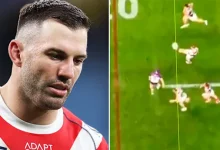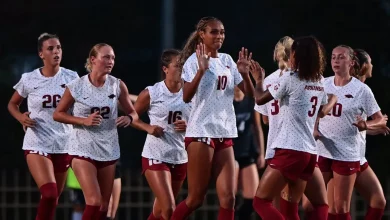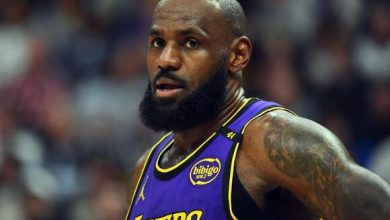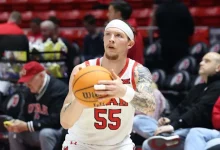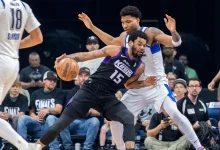The 1959–60 Ohio State Buckeyes, led by Hall of Fame coach Fred Taylor, featured future legends Jerry Lucas, John Havlicek, and Bob Knight.
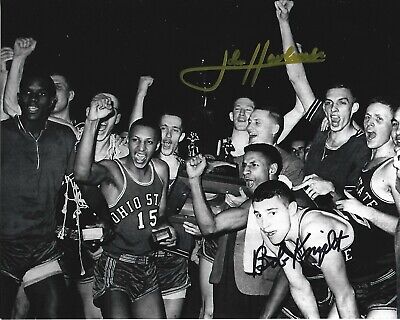
The 1959–60 Ohio State Buckeyes men’s basketball team stands as one of the most iconic and historically significant squads in college basketball history. Coached by the legendary Fred Taylor, this team would not only leave its mark on Ohio State’s storied basketball program but would also shape the trajectory of college basketball in general.
The 1959–60 season culminated in the Buckeyes winning their first and only NCAA National Championship in men’s basketball, forever securing their place in the annals of the sport’s history. With the talent that graced the roster, including future NBA stars and Hall of Famers, this team is often regarded as one of the most well-rounded and dominant groups to ever play college basketball. What makes their achievement even more remarkable is the level of individual excellence within the team, with players like Jerry Lucas, John Havlicek, and Bob Knight, who would go on to not only excel in their collegiate careers but also leave indelible marks in the professional ranks.
Coach Fred Taylor’s Leadership
At the helm of the 1959–60 Ohio State Buckeyes was Fred Taylor, a coach who would go on to become a legendary figure in college basketball. Taylor was not only known for his tactical acumen but also for his ability to motivate and unify players, building a team-oriented culture that was central to the Buckeyes’ success. Under his leadership, the Buckeyes played a brand of basketball that was methodical, disciplined, and rooted in teamwork.
Fred Taylor had a distinct ability to identify and nurture talent, and his coaching methods were instrumental in harnessing the potential of players like Jerry Lucas, John Havlicek, and Bob Knight. But beyond his coaching prowess, Taylor was also respected for his ability to create a cohesive team dynamic, where individual accolades were secondary to collective success. His approach allowed each player to excel within their specific roles, creating a team that was greater than the sum of its parts.
Jerry Lucas: The Heart of the Buckeyes
Arguably the most prominent member of the 1959–60 Ohio State team was Jerry Lucas, a player whose combination of size, skill, and basketball IQ made him a dominant force in college basketball. At 6’8”, Lucas played as a center and forward and was widely regarded as one of the most complete players in the game at the time. His versatility, ability to score in the post, and his rebounding ability set him apart from most of his contemporaries.
Lucas’ impact on the Buckeyes was immeasurable. He was not only the team’s leading scorer but also its emotional leader. He could dominate on both ends of the floor, combining his offensive skills with a tenacious defense that made him a nightmare for opposing teams. In the 1959–60 season, Lucas averaged a double-double, with 21.0 points and 15.0 rebounds per game, putting him in the conversation as one of the best players in college basketball history.
Beyond his physical attributes, Lucas had an unmatched understanding of the game. His passing ability, especially for someone of his size, was ahead of its time, and he could facilitate offense in ways that were rare for players of his position. He played with a level of basketball IQ that was apparent in every game he played, and his influence on the team was a critical factor in Ohio State’s success that season.
Lucas’ success wasn’t limited to the college game. He would go on to have a Hall of Fame career in the NBA, becoming one of the league’s top players during the 1960s and 1970s, making multiple All-Star teams, and leading the league in rebounds at one point in his career. He was a dominant force in the NBA and cemented his legacy as one of the game’s greatest players.
John Havlicek: The Versatile Star
Alongside Lucas was John Havlicek, another future Hall of Famer whose versatility and work ethic made him an indispensable part of the 1959–60 Ohio State team. Havlicek played as a forward and guard and was known for his ability to contribute in all facets of the game. His athleticism and stamina were unparalleled, and he had an innate ability to impact both ends of the floor.
Havlicek’s ability to play multiple positions allowed Fred Taylor to use him in various roles, whether it was scoring, rebounding, or playing lockdown defense. His quickness and agility made him a nightmare for defenders, and his relentless energy set the tone for the Buckeyes’ fast-paced style of play. Over the course of the season, Havlicek averaged 16.0 points per game, providing a dynamic offensive option alongside Lucas.
Havlicek’s time at Ohio State was just the beginning of what would become a legendary career in the NBA. After joining the Boston Celtics, he quickly became one of the league’s most celebrated players, known for his clutch performances, particularly in the postseason. Havlicek’s ability to defend, score, and pass made him one of the most complete players of his era. He would go on to win multiple NBA championships with the Celtics and be inducted into the Naismith Memorial Basketball Hall of Fame.
Bob Knight: The Future Coaching Legend
While Lucas and Havlicek were the stars of the team, Bob Knight was a key contributor who also would later leave an indelible mark on the basketball world as a coach. Knight played as a reserve forward on the 1959–60 Ohio State team, but it was clear even then that he had the leadership qualities and basketball knowledge that would eventually propel him to greatness.
Though Knight’s playing time was somewhat limited during his time at Ohio State, he was still a vital part of the team’s success, providing depth and defensive prowess. However, it was his future as a coach that would make him a household name. After graduating from Ohio State, Knight went on to have an iconic career as a head coach, most notably at Indiana University, where he became one of the most successful and controversial figures in the history of college basketball. He would go on to win three NCAA championships at Indiana, and his no-nonsense coaching style became synonymous with disciplined, tough basketball.
Despite his limited playing time at Ohio State, Knight’s inclusion on this roster was essential for the team’s championship run. His competitive nature and leadership qualities, which would later define his coaching career, were apparent even in his college days.
The 1959–60 Ohio State Season
The 1959–60 season was a breakthrough year for Ohio State basketball. The team entered the season with high expectations, and with Lucas, Havlicek, and Knight on the roster, the Buckeyes quickly established themselves as a powerhouse in college basketball. The team dominated its competition in the regular season, finishing with a 25-2 record and earning a trip to the NCAA tournament.
In the tournament, Ohio State faced some tough competition but was able to showcase its depth and talent. The Buckeyes made their way to the championship game, where they faced the California Golden Bears in a thrilling final. The game was hard-fought, but with the leadership of Lucas and the contributions of Havlicek and Knight, Ohio State emerged victorious, claiming their first-ever NCAA National Championship.
The Legacy of the 1959–60 Buckeyes
The 1959–60 Ohio State Buckeyes not only left an indelible mark on the program but also on college basketball as a whole. The team’s success helped elevate Ohio State to national prominence and solidified its place among the elite programs in the country. The players from this team, especially Lucas, Havlicek, and Knight, would go on to achieve great success in professional basketball and coaching, ensuring that their legacy would endure for generations to come.
While the 1959–60 Buckeyes are remembered primarily for their national championship victory, it is the individual excellence of players like Jerry Lucas, John Havlicek, and Bob Knight that truly defines their legacy. The combination of talent, leadership, and coaching under Fred Taylor created a team that was greater than the sum of its parts, and that remains a model for success in college basketball to this day.

